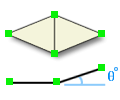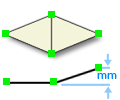The Create Regions dialog allows you to define areas on the mesh and then assign default properties to these regions. It is often easier to work with regions rather than a mesh, because when using a region it is possible to group mesh elements together logically and ensure that individual mesh elements are not omitted from receiving a property.
Regions are always planar. Since mesh elements may deviate slightly from being coplanar, you can specify a tolerance within which adjacent mesh elements will be considered part of the same plane. By doing this, you can ensure that they become part of the same region.
There are two types of tolerance to choose from: angular or planar. The angular tolerance enables you to specify the maximum allowable angle between mesh elements in degrees as shown in the image below left. The Planar tolerance enables you to specify the maximum allowable distance from the same plane between mesh elements in mm, as shown in the image below, right. Angular tolerances are often used for parts with large curved surfaces. Planar tolerances are used when you want to preserve the shape of your part.


Create Regions from Mesh/STL produces one region that includes all the mesh elements.
- Click
 ().
(). - Click either Planar or Angular in the Tolerance area and enter a value.
- Click STL or Mesh in the Create from area, depending on the type of model used.
- Optional: Click
 Browse in the Selection option group and select a different property type for the region to be created.
Browse in the Selection option group and select a different property type for the region to be created. - Click Apply. Regions are created on the model as specified in step 4.